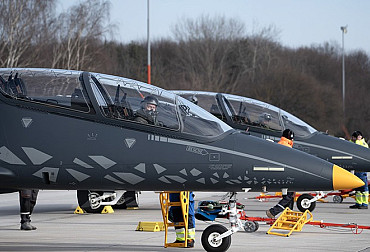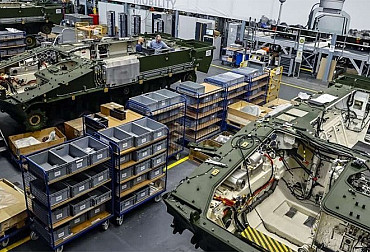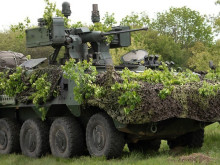Czech Army took over all TITUS vehicles in the artillery version
In August, the last pieces of modern TITUS armoured vehicles in the MKPP (fire support coordination point) version were handed over at the Army's Technical Services Material Security Centre in Štěpánov near Olomouc. By this act, the supplier, Eldis Pardubice, together with the manufacturer and integrator, Tatra Defence Vehicle, fulfilled one of their commitments to the Czech Army to deliver a total of 62 TITUS vehicles of all versions.

In August, the last pieces of modern TITUS armoured vehicles in the MKPP (fire support coordination point) version were handed over at the Army's Technical Services Material Security Centre in Štěpánov near Olomouc. By this act, the supplier, Eldis Pardubice, together with the manufacturer and integrator, Tatra Defence Vehicle, fulfilled one of their commitments to the Czech Army to deliver a total of 62 TITUS vehicles of all versions.

The new TITUS vehicles in the MKPP version will primarily serve with the 13th Artillery Regiment in Jince, where they will replace the obsolete Praga V3S vehicles. In the coming months, artillery specialists will implement and install the modern Adler III CZ fire control system in the MKPP TITUS, which will ensure full automation of the army artillery's fire control and coordination processes. The training of TITUS vehicle drivers has already started during August at the 13th Artillery Regiment, followed by the training of special equipment operators. Once the training is complete, the vehicles and crews will be fully ready for their tasks, and the army expects to deploy these modern vehicles in foreign operations as well.

The MKPP version of TITUS will support the decision-making processes of commanders of mechanized units and artillery in planning and controlling combat and will streamline the process of command and control of subordinate elements in various combat conditions on the ground and on the move. In addition to the vehicle command and control processes, it will also provide liaison and data communication between the individual elements of the artillery combat formation with the senior all-arms commander. Thus, MKPPs will act as command and staff sites for both fire support coordination and fire control, at the brigade (SKP - Fire Coordination Centre), battalion (MKP - Fire Coordination Point), squad (FCC - Fire Control Centre) and battery (FCC - Fire Control Point) levels.
The above-mentioned functions of the TITUS MKPP vehicle will be provided by software applications, while the uniformity of the equipment and ergonomics of the vehicle interiors of all versions can be maintained. The information technology and hardware built into the MKPP vehicles enables the installation of the software of the Adler III CZ advanced automated fire control system (AFCS). As a result, MKPP will significantly reduce the reaction time of artillery units, significantly increase the speed of artillery systems deployment and the mobility of the entire fire support system.
The electronic and communication systems in MKPP vehicles will provide classified and unclassified radio communication and data link in VHF and UKV bands, as well as satellite tactical communication (SATCOM), including the use of integrated cryptomodules. Thanks to the state-of-the-art equipment, MKPP TITUSes will be able to process information up to "T" level. The Battle Command Information System (BCIS) is divided into a Black section (unclassified or encrypted data processing zone) and a Red section (classified data processing zone). The two zones of the BVIS are separated by a certified security filter that allows bi-directional transmission of predefined data between them.
The body of the MKPP is structurally identical to other versions of TITUS vehicles and is welded from armoured sheet metal, with armoured plates on the outside and composite materials lining the inside walls (spall liner). Mine resistance is at level 3a and 3b, ballistic resistance is at level 3 according to STANAG 4569, while the armoured windows have the same level of resistance. The basic platform is a three-axle Tatra T 815-7M0B31.262 chassis with a wheelbase of 2550 + 2550 mm. The chassis consists of a central support tube with swinging independently suspended semi-axles with air suspension and an auxiliary frame to which the armoured body is directly mounted. Power is provided by a Cummins ISM 10 824 cc turbocharged, in-line, water-cooled, in-line six-cylinder diesel engine with charge air cooling, producing 373 kW and 2 102 Nm of torque.
 Picture: The maximum speed is limited to 90 km/h and the vehicle has a range of up to 800 km thanks to a 360 litre fuel tank | Michal Pivoňka / CZ DEFENCE
Picture: The maximum speed is limited to 90 km/h and the vehicle has a range of up to 800 km thanks to a 360 litre fuel tank | Michal Pivoňka / CZ DEFENCE
All wheels are driven and fitted with reduction gears, inner range hoops (runflats) and a central inflation system. The first and third axles are steerable, the rotation of the third axle can be maximum up to a speed of 10 km/h, it is progressively reduced up to a speed of 45 km/h, above 45 km/h the steering is locked, but can be locked at any time using a switch from the driver's seat. The transmission consists of a fully automatic six-speed Allison gearbox and a two-speed Tatra auxiliary gearbox. Top speed is limited to 90 km/h and the vehicle has a range of up to 800 km thanks to a 360 litre fuel tank.





















